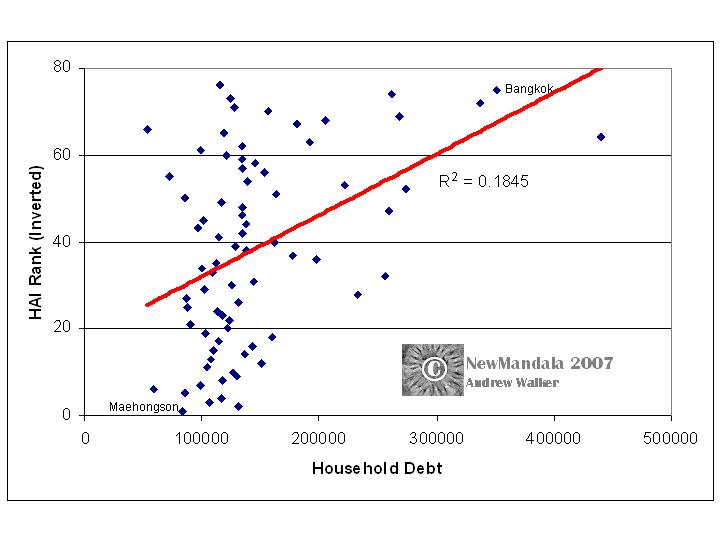In my post of earlier today I discussed the emphasis placed in Thailand’s 2007 Human Development Report on “sufficiency economy.” As I work through the report I will provide a series of posts (as time permits) on some of its key issues. In this post I focus on Chapter 1 in which the key human development data are presented.
The message of this chapter is straightforward: Thailand has made “remarkable progress” in relation to human development but “this progress has not benefited everyone equally.” One indicator of the progress is the reduction in poverty – from 38 percent in 1990 to 11 percent in 2004. The report notes that Thailand is expected to meet most or all of the Millennium Development Goals in advance of the 2015 target. But the inequalities are stark. The report provides a ranking of Thailand’s 76 provinces in terms of their Human Achievement Index (HAI) Score. This HAI score provides a summary of a wide range of human development indicators relating to health, education, income, housing, community, communications and participation. Phuket rates the highest, followed by Bangkok. Of the other 10 top-ranked provinces five are in the central region. By contrast, Mae Hong Son in the far north ranks at the bottom. Eight of the bottom 10 provinces are in the North or Northeast. Two are in the South. In brief:
People in Bangkok, Bangkok Vicinity and other regional growth areas enjoy higher levels of human development than people in more isolated provinces. The North and the Northeast, as well as a few provinces in the deep South, are placed at much lower levels.
The report provides data and insights on various dimensions of this inequality. Compared to those in Bangkok people in the Northeast and North are more likely to be disabled and more likely to report physical illness but they have much lower access to health services; they also have lower access to education; they have lower standards of housing and living environment; lower access to mobile phones and the internet; and they are much more likely to be living in poverty. In brief the report provides a compelling account of Thailand’s regional inequality.
This chapter of the Human Development Report makes almost no mention at all of the “sufficiency economy” approach. This is unfortunate. It would have been very interesting if the authors had made some attempt to map some key indicators of sufficiency economy and see how these correlate with the Human Achievement Index. As I said in my previous post, superficial inspection suggests that there may be an inverse relationship between sufficiency economy and human development. To put it bluntly, I suspect Mae Hong Son (at the bottom of the HAI table) contains many more people living a sufficiency lifestyle than the high-ranking Bangkok or Phuket.
What could be some useful indicators of “sufficiency economy”? Perhaps the percentage of a province’s agricultural land devoted to subsistence crops. Or the percentage of provincial income derived from local production. Or the proportion of household income spent on basic consumption. All these may be possible proxy indicators for the presence or otherwise of sufficiency economy. Another may be the level of household debt, given that sufficiency economy is often presented as an antidote to debt-fuelled pursuit of economic expansion. Data on household debt (by province) is available in the Human Development Report (Table All4).
Taking the level of household debt by province as a very rough proxy for sufficiency economy (lower debt indicates more sufficiency economy) I thought it would be interesting to see how this correlates with the overall HAI rankings. I plotted the relationship in this graph (click it for a larger image):
The horizontal axis shows the level of household debt by province. Bangkok’s average debt is 351,000 while Mae Hong Son’s is 83,112. The vertical axis indicates the HAI ranking – those low on the axis rate low on the HAI (Mae Hong Son rates 76) while those high on the axis rate high on the HAI (Bangkok rates 2).
The result is interesting, though not compelling. It does suggest that there is some tendency for higher levels of debt to correspond with higher HAI rankings. Very generally, the less human developed provinces tend to have lower debt levels. And the more human developed provinces have higher debt levels. In other words, based on this very rough and limited calculation there is some suggestion that higher levels of sufficiency economy (such as in Mae Hong Son) correlate to some extent with lower levels of human development.
Interesting. And surely worth further investigation. Before Thailand goes too far down the sufficiency economy path it may be worth investigating the current distribution of key features of sufficiency economy and how they relate to other key measures of human development.
 Facebook
Facebook  Twitter
Twitter  Soundcloud
Soundcloud  Youtube
Youtube  Rss
Rss 